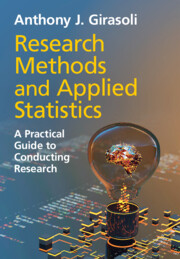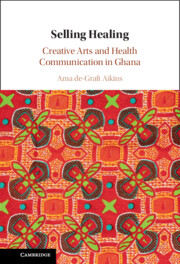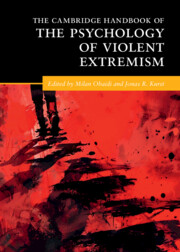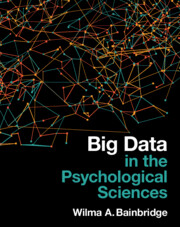Refine search
Actions for selected content:
421 results

Research Methods and Applied Statistics
- A Practical Guide to Conducting Research
- Coming soon
-
- Expected online publication date:
- December 2025
- Print publication:
- 02 October 2025
-
- Textbook
- Export citation

Selling Healing
- Creative Arts and Health Communication in Ghana
-
- Published online:
- 07 November 2025
- Print publication:
- 20 November 2025
Educational Expertise, Networks, and Policy-Making under State Socialism: School Maturity in Czechoslovakia and Poland (1950s-1970s)
-
- Journal:
- History of Education Quarterly , First View
- Published online by Cambridge University Press:
- 07 November 2025, pp. 1-29
-
- Article
-
- You have access
- Open access
- HTML
- Export citation
Conclusion
-
- Book:
- Moral Heroism without Virtue
- Published online:
- 23 October 2025
- Print publication:
- 06 November 2025, pp 189-192
-
- Chapter
- Export citation

The Cambridge Handbook of the Psychology of Violent Extremism
-
- Published online:
- 31 October 2025
- Print publication:
- 07 August 2025

Foundations of MATLAB Programming for Behavioral Sciences
- With Applications
-
- Published online:
- 28 October 2025
- Print publication:
- 07 August 2025
-
- Textbook
- Export citation
Gaming’s hidden gamble: are we betting more than we realise?
-
- Journal:
- Irish Journal of Psychological Medicine , First View
- Published online by Cambridge University Press:
- 27 October 2025, pp. 1-3
-
- Article
-
- You have access
- HTML
- Export citation

Big Data in the Psychological Sciences
-
- Published online:
- 23 October 2025
- Print publication:
- 23 October 2025
-
- Textbook
- Export citation
Chapter 17 - Bloomsbury and Psychoanalysis
- from Part III - Intimate Bloomsbury
-
-
- Book:
- A History of the Bloomsbury Group
- Published online:
- 09 October 2025
- Print publication:
- 23 October 2025, pp 280-296
-
- Chapter
- Export citation
1 - What Is Big Data?
-
- Book:
- Big Data in the Psychological Sciences
- Published online:
- 23 October 2025
- Print publication:
- 23 October 2025, pp 1-12
-
- Chapter
- Export citation

Can the Public be Trusted?
- On the Promise and Perils of Voluntary Compliance
-
- Published online:
- 11 October 2025
- Print publication:
- 30 October 2025
-
- Book
-
- You have access
- Open access
- Export citation
Chapter 6 - Intergroup Relations in the World Ecological and Environmental Context
- from Part II - The New Psychology of Intergroup Relations
-
- Book:
- The Psychology of System Change and Resistance to Change
- Published online:
- 23 September 2025
- Print publication:
- 09 October 2025, pp 121-139
-
- Chapter
- Export citation
Facilitators of and barriers to patient and public involvement in mental health research within university settings: a systematic review and meta-synthesis
-
- Journal:
- Psychological Medicine / Volume 55 / 2025
- Published online by Cambridge University Press:
- 06 October 2025, e297
-
- Article
-
- You have access
- Open access
- HTML
- Export citation

Manufacturing Dissent
- American Modernism and the Science of Belief
-
- Published online:
- 03 October 2025
- Print publication:
- 21 August 2025
15 - Men’s Prison Memoirs of Trauma and Recovery
- from Part IV - Survivors
-
-
- Book:
- The Cambridge Companion to American Prison Writing and Mass Incarceration
- Published online:
- 02 October 2025
- Print publication:
- 02 October 2025, pp 245-260
-
- Chapter
- Export citation
Chapter 1 - Staging Consent
-
- Book:
- Manufacturing Dissent
- Published online:
- 03 October 2025
- Print publication:
- 21 August 2025, pp 16-57
-
- Chapter
- Export citation
Introduction
-
- Book:
- Manufacturing Dissent
- Published online:
- 03 October 2025
- Print publication:
- 21 August 2025, pp 1-15
-
- Chapter
- Export citation
Chapter 5 - The Psychological Type of the Redeemer
-
- Book:
- Nietzsche on the Methods and Aims of Philosophy
- Published online:
- 25 July 2025
- Print publication:
- 14 August 2025, pp 101-121
-
- Chapter
- Export citation
9 - Hip-Hop and Mental Health
- from Part III - Applications of Rap
-
-
- Book:
- The Cambridge Companion to Global Rap
- Published online:
- 25 July 2025
- Print publication:
- 14 August 2025, pp 144-157
-
- Chapter
- Export citation
3 - The Future of Violent Extremism Research
- from Part I - Concepts, Definitions, and Trends
-
-
- Book:
- The Cambridge Handbook of the Psychology of Violent Extremism
- Published online:
- 31 October 2025
- Print publication:
- 07 August 2025, pp 28-46
-
- Chapter
- Export citation
